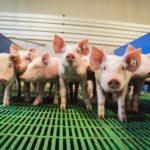Swine Ileitis
Also called Porcine Proliferative Enteropathy (PPE), ileitis is an infectious enteric disease. Its prevalence is considerably high in Europe and in Asia, reaching over 90% of the farms and is characterized by thickening of the mucosa of the intestine due to hyperplasia of the crypt enterocytes.
The disease is due the contamination of Lawsonia intracellularis. Once in the digestive tract, bacteria are able to overpass the stomach acidity to colonize the intestine. The damages are happen mostly in the Ileum, where inflammation of the enterocytes causes immature epithelium development. This leads to a reduction of the nutrient absorption, and consequently to a negative impact on the swine growth (up to -40% on the feed converting ratio).
Due to ileitis, mortality is observed to reach up to 5% in case of severe contamination, especially when pens are clean with a contamination happening at the late fattening stage (>80kg). Then pigs might not have set up its immunity to Lawsonia intracellularis at the earlier stages, inducing important deficiency in the body. The losses can reach up to 20$ per infected pig in the flock.
On the other hand, in farms that have heavy pathogenic pressure, contamination is more likely to happen on piglets and young growers, so the growth performances are impacted on the whole fattening period – even if mortality can stay reasonable. This is why, in both case, ileitis is costly. A loss of 0,5 pts on the FCR would induce an increase of the feed consumption by 45kg/pig.
Swine Dysentery
Often being confused with Ileitis, the Swine Dysentery (SD), also known as one of the major diseases in swine farm. The disease is caused by Brachyspira hyodysenteriae and Brachyspira pilosicoli and, like Ileitis, contamination is known to happen orally and spread to the environment via the infected feces. SD ranges from mild, mucous diarrhea with unaltered general condition, to severe hemorrhagic diarrhea. Heavily infected pigs are condemned to stay infected, conducting to high mortality rate that can reach from 50% to 90%.
Preventive strategy is the best solution to control the disease. This is why a strong biosecurity and closed pens are essential to avoid the spreading of the disease. In addition, managing intestinal microbiota in a way to lower pathogenic bacteria loud (LI and BH) could help to control the disease.
NSOAB9®
Nor-Feed has specifically designed a product called NSOAB9®, based on plant extracts and standardized on selected saponins and flavonoids. The combination contibutes to the modulation of the gut microbiota.

A trial with NSOAB9® demonstrated its efficacy via a RT-PCR test, showing a reduction of the targeted pathogens by 90% after 56 days (Figure 1).
Used preventively in farms with high risk of Ileitis and or Swine Dysentery, NSOAB9® has shown its capacity to maintain good performances in degraded sanitary conditions.
Fig. 1: RT-PCR realized on pig feces contaminated by Brachypira.h and Lawsonia.i at days 120 and 176.
Sources: A. Benarbia, P. Chicoteau and Okuma Tsuguaki; NSOAB9® supplementation reduces fecal shedding of Lawsonia.i and Brachyspira.h in fattening pigs.
About Nor-Feed
Since 2003, Nor-Feed invents, manufactures and markets natural plant extracts for animal nutrition and health. Nor-Feed is focused on a short product portfolio; our products are standardized, documented and efficient, with sustainable development principles. Nor-Feed provides its clients with technical, marketing and regulatory support.
CONTACT: contact@norfeed.net

